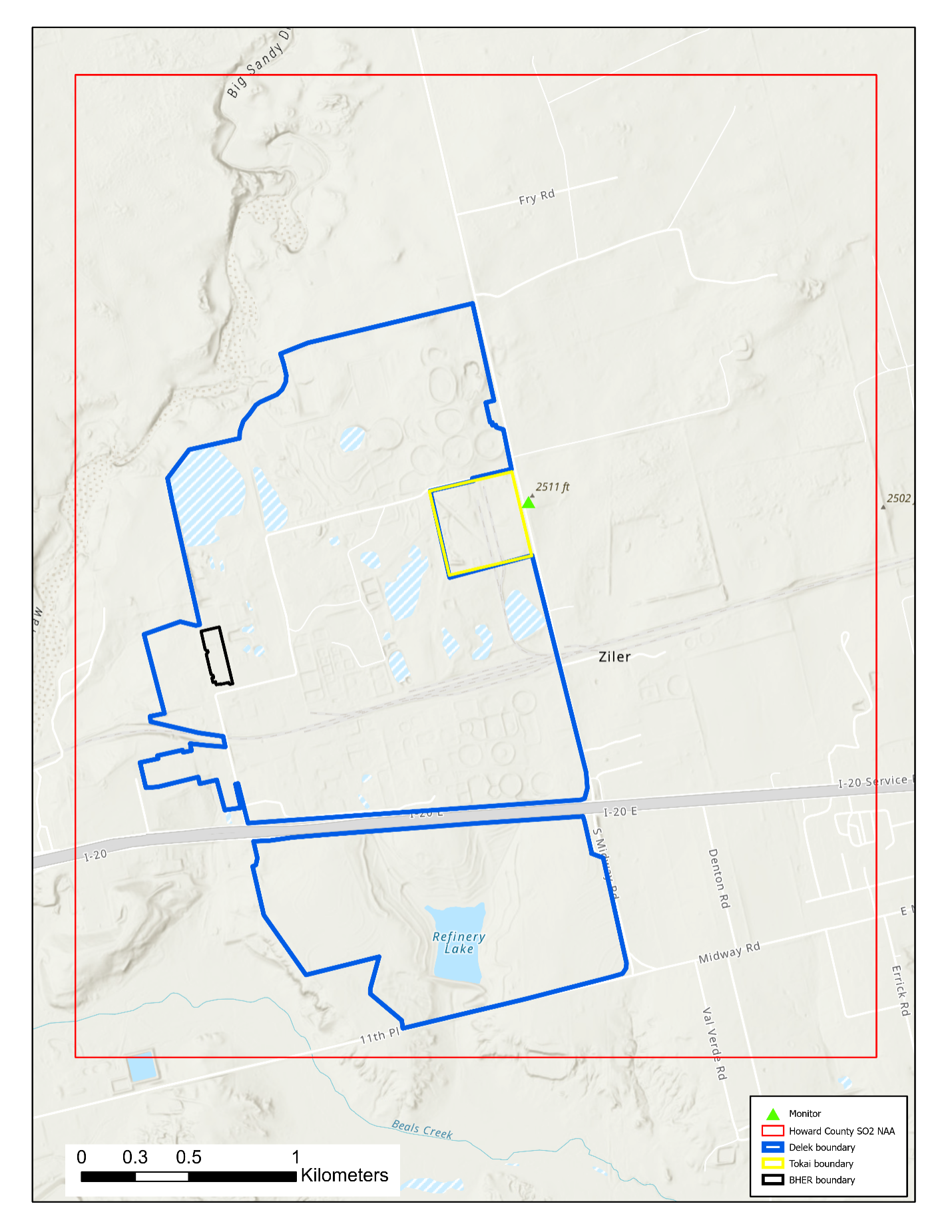Sulfur Dioxide Dispersion Modeling for Howard County
Air dispersion and stochastic modeling methods, files, and data to support the Howard County sulfur dioxide attainment demonstration for the State Implementation Plan (SIP) revision.
A portion of Howard County does not meet the 2010 Sulfur Dioxide (SO2) National Ambient Air Quality Standard (NAAQS) . TCEQ has developed a plan to demonstrate how the area will meet the SO2 standard. Below is TCEQ's dispersion modeling that was used for developing the plan, including a description of the pollution sources and the surrounding area.
If you have questions about these files, please email amda@tceq.texas.gov with "Howard SO2 Dispersion Modeling Files" in the subject line.
Area Overview
The Howard County 2010 SO2 NAAQS nonattainment area contains three sites (outlined in blue, yellow, and black on the map), each with multiple sources of SO2 emissions, that are included in the attainment demonstration modeling. The Big Spring Midway monitor, or Continuous Ambient Monitoring Station 1072 (C1072) is required under the Data requirements Rule and was sited (green triangle on the map) across North Midway Road approximately 0.15 kilometer to the northeast of the Tokai Plant, to monitor SO2 concentrations. The closest surface and upper air weather stations are located at the Midland International Airport (WBAN 23023).

Model Configuration
The sources for the Howard County 2010 SO2 NAAQS nonattainment area were modeled with the standard practices outlined in Appendix W, Guideline on Air Quality Models .
Air Dispersion Model: AERMOD version 21112
AERMOD Preprocessors:
- AERMET version 21112 to generate meteorological data files.
- AERMINUTE version 15272 to include measured one-minute wind averages.
- AERSURFACE version 20060 to determine the surface characteristics for the meteorological station.
- AERMAP version 18081 to gather elevation data for sources and receptors.
- The Building Profile Input Program for PRIME (BPIPPRM) version 04274 to calculate building downwash effects.
Meteorological Years Modeled: 2016 through 2020
MC Approach: In the Howard County nonattainment area, four flares at the Delek US Holdings' facility emit SO2 intermittently and randomly during maintenance, startup, and shutdown operations. To better characterize the variability of these sources, TCEQ contracted with Ramboll US Corporation to develop the MC Approach, which uses a Monte Carlo method in conjunction with the recommended air dispersion modeling. The MC approach was used to estimate modeled design values more realistically since dispersion modeling of these sources continually results in unrealistic emission scenarios. The MC approach resulted in TCEQ conducting more than 2 million simulations where the Delek US Holdings' flares were operated randomly to ensure that the Howard County nonattainment area will remain in attainment under the different operating conditions. More information about the MC approach can be found in Appendix L of the SIP revision.
Background Concentration: The background SO2 concentration used for this modeling was calculated for each hour and season by averaging the 99th percentile hourly values for 2018 through 2020 from the Midlothian Old Fort Worth monitor (C52).
Modeling Data Files
You may view and download the model runs and control file inputs described below from the TCEQ Air Modeling secure FTP site . To download a large quantity of modeling files, please use an FTP client software, such as FileZilla , to access our secure FTP site:
- FTP address: sftp://amdaftp.tceq.texas.gov
- FTP directory: /SO2/Howard/adoption/AERMOD & /SO2/Howard/adoption/MC_Approach
- User ID and password: Please sign up for a user account at https://amdaftp.tceq.texas.gov/user/
Data available includes:
- Ancillary inputs (downwash, meteorology, and receptor input data).
- Run directories containing control files and model output.
AERMOD and its preprocessor source code and executables are available on the US Environmental Protection Agency's website .
If you would like to request additional data related to the modeling for this SIP revision, please email amda@tceq.texas.gov with "Howard County SO2 Modeling Files - Data Request" in the subject line and specify which data you are requesting.
SIP Revision and Related Appendices
Documents for the SIP revision and appendices related to this modeling are below:
- Howard County Attainment Demonstration SIP Revision for the 2010 SO2 NAAQS
- Appendix K: Modeling Technical Support Document (TSD)
- Appendix L: Howard County Monte Carlo Simulation
For more on this SIP Revision, visit the Air Pollution from Sulfur Dioxide webpage.
